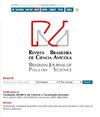The Effect of Space Allowance During Pre-Slaughter Transport of European Quail Breeders on Welfare, Carcass Traits and Meat Quality
IF 1.1
4区 农林科学
Q3 AGRICULTURE, DAIRY & ANIMAL SCIENCE
引用次数: 0
Abstract
The objective was to evaluate whether space allowance during pre-slaughter transport of European breeding quail affects welfare, carcass traits and meat quality. A total of 248 quails (body weight = 344.90 ± 2.09 g) were used. During pre-transport, the quails were fasted for 5 hours and 30 minutes. The poultry were caught and placed in plastic transport crates with an area of 0.40 m 2 . The treatments consisted of a different space allowance in each crate: 22, 28, 34 or 40 quails per crate. Immediately upon arrival at the slaughterhouse, the quails were stunned. During bleeding, blood samples were collected. The carcasses were individually weighed. The meat quality was measured. Data were analysed using the effects of space allowance during transport of quails and pickup truck as dependent variables. Death on arrival increased as the space allowance in transport crates decreased ( p =0.08). Glucose and uric acid levels were not significantly different between groups ( p ≥0.14). The cold carcass weight presented the maximum value when the crates contained 31 quails ( p =0.03). The meat pH, intensity of red, intensity of yellow and cooking losses were not different between groups ( p ≥0.12). The meat lightness value presented the maximum value when the crates contained 31 quails ( p =0.04). In view of the above, the number of European breeding quails transported in crates must not exceed 30 animals.屠宰前运输空间补贴对欧洲鹌鹑养殖者福利、胴体性状和肉质的影响
本文章由计算机程序翻译,如有差异,请以英文原文为准。
求助全文
约1分钟内获得全文
求助全文
来源期刊

Brazilian Journal of Poultry Science
农林科学-奶制品与动物科学
CiteScore
1.80
自引率
9.10%
发文量
60
审稿时长
>12 weeks
期刊介绍:
A Revista Brasileira de Ciência Avícola surgiu em 1999 a partir da necessidade que a comunidade científica possuía de um periódico para veiculação e publicação de seus trabalhos, com a publicação de três números anuais.
A Revista conta hoje com um corpo editorial altamente qualificado e com artigos científicos desenvolvidos pelos maiores especialistas da área, o que a cada dia atrai mais leitores em busca de inovação e respaldo técnico.
Devido à credibilidade que conquistou pelos esforços de sus autores, relatores e revisores, a Revista ganhou caráter de coleção, sendo consultada como fonte segura de estudo desenvolvidos na Avicultura.
A partir de 2003 – volume 5 -, a Revista passou a chamar-se Brazilian Journal of Poultry Science, e todos os trabalhos passaram a ser publicados em inglês. No mesmo ano subiu para quatro o número de revistas por volume, ampliando-se assim os trabalhos publicados anualmente.
 求助内容:
求助内容: 应助结果提醒方式:
应助结果提醒方式:


